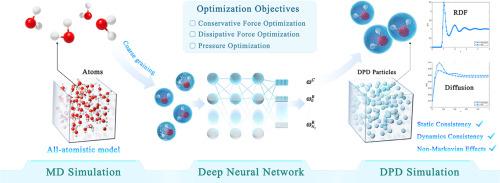非马尔可夫智能耗散粒子动力学集成与机器学习增强粗粒度模拟
IF 3.8
2区 物理与天体物理
Q2 COMPUTER SCIENCE, INTERDISCIPLINARY APPLICATIONS
引用次数: 0
摘要
我们提出了一种基于机器学习的粗粒度方法,该方法将分子动力学(MD)与耗散粒子动力学(DPD)相结合,以解决粒子运动和波动力表现出重叠时间尺度的系统中马尔可夫近似的局限性。我们的方法,称为非马尔可夫智能耗散粒子动力学(NM-IDPD),利用MD数据来训练一个能够预测DPD框架内的保守力和耗散力的神经网络,有效地解释了非马尔可夫效应。我们还在神经网络中加入了压力约束机制,以准确捕获系统压力,这对于大多数传统的粗粒度方法来说都是一个具有挑战性的问题。通过对星形聚合物、甲烷和水系统的应用,NM-IDPD在不同时间尺度上复制模拟系统的静态和动态特性方面表现出了良好的性能。这一进展为材料动力学模拟提供了一条有前途的途径,提高了复杂系统计算建模的准确性和效率。本文章由计算机程序翻译,如有差异,请以英文原文为准。

Non-Markovian intelligent dissipative particle dynamics integrated with machine learning for enhancing coarse-grained simulations
We propose a machine learning-based coarse-grained method that integrates molecular dynamics (MD) with dissipative particle dynamics (DPD) to address the limitations of the Markovian approximation in systems where particle motion and fluctuating forces exhibit overlapping time scales. Our approach, termed non-Markovian intelligent dissipative particle dynamics (NM-IDPD), utilizes MD data to train a neural network capable of predicting both conservative and dissipative forces within the DPD framework, effectively accounting for non-Markovian effects. We have also incorporated a pressure constraint mechanism into the neural network to accurately capture the system pressure, which is a challenging issue for most traditional coarse-grained methods. Through applications to star polymers, methane, and water systems, NM-IDPD has demonstrated good performance in replicating both the static and dynamic properties of simulated systems across various time scales. This advancement offers a promising avenue for material dynamics simulation, enhancing the accuracy and efficiency of computational modeling in complex systems.
求助全文
通过发布文献求助,成功后即可免费获取论文全文。
去求助
来源期刊

Journal of Computational Physics
物理-计算机:跨学科应用
CiteScore
7.60
自引率
14.60%
发文量
763
审稿时长
5.8 months
期刊介绍:
Journal of Computational Physics thoroughly treats the computational aspects of physical problems, presenting techniques for the numerical solution of mathematical equations arising in all areas of physics. The journal seeks to emphasize methods that cross disciplinary boundaries.
The Journal of Computational Physics also publishes short notes of 4 pages or less (including figures, tables, and references but excluding title pages). Letters to the Editor commenting on articles already published in this Journal will also be considered. Neither notes nor letters should have an abstract.
 求助内容:
求助内容: 应助结果提醒方式:
应助结果提醒方式:


